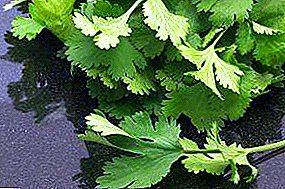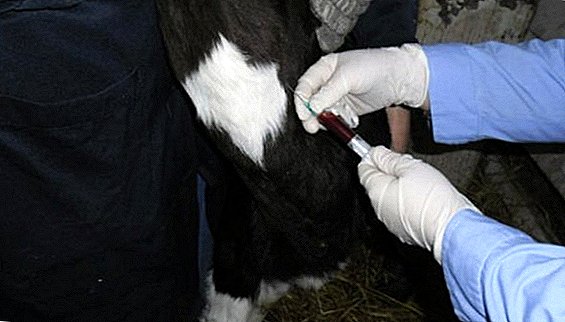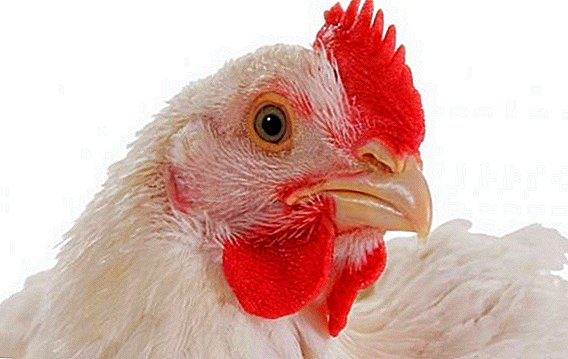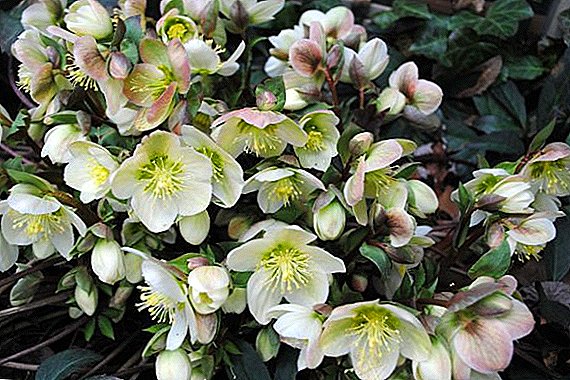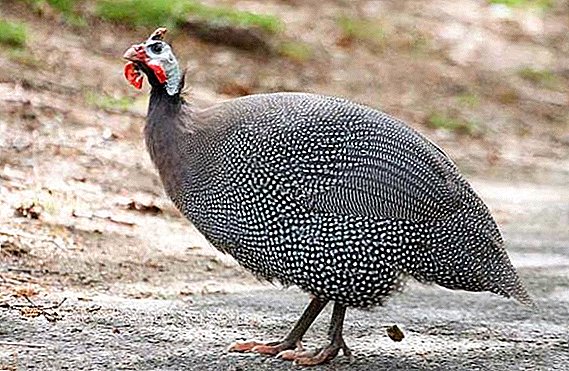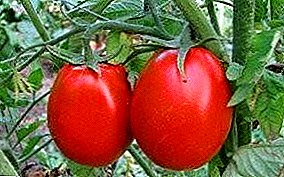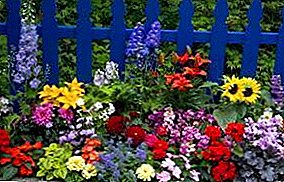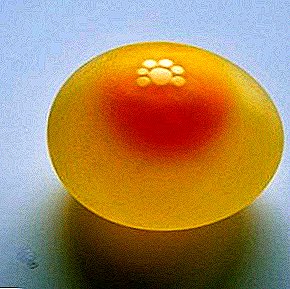 Providing the rabbits with the necessary food in the winter time causes difficulties not only for beginners, but also for experienced owners who have been breeding these animals for decades. Consider the feed, which is used for fattening in the winter, we will tell you about the differences from the summer diet, as well as about what to feed different age groups of rabbits.
Providing the rabbits with the necessary food in the winter time causes difficulties not only for beginners, but also for experienced owners who have been breeding these animals for decades. Consider the feed, which is used for fattening in the winter, we will tell you about the differences from the summer diet, as well as about what to feed different age groups of rabbits.
Features winter nutrition
If in summer, the animal's body spends energy to ensure the functioning of organs and their systems, and the excess is deposited in the form of fat reserves, in winter additional costs arise due to a decrease in ambient temperature. The body spends a large amount of energy to maintain a normal temperature.  In summer, the rabbit needs plenty of fluids., to compensate for its loss due to evaporation at sufficiently high temperatures, so the diet is dominated by juicy vegetable food, which, although it does not provide a large number of calories, but provides the animal with the necessary moisture.
In summer, the rabbit needs plenty of fluids., to compensate for its loss due to evaporation at sufficiently high temperatures, so the diet is dominated by juicy vegetable food, which, although it does not provide a large number of calories, but provides the animal with the necessary moisture.
In winter, it is not difficult to keep the water balance, as sweating is minimized. At the same time, the caloric intake of the diet should increase substantially so that the rabbit's body does not use fat reserves, but, on the contrary, accumulates them. That is why in winter you need to give high-calorie fortified food, which will increase the weight of the animal.
Changing the diet in winter is also caused by the lack of fresh vegetable feed, and the dry version will not give the animal the necessary vitamins, elements and energy. For this reason, rabbits are fed various root crops, concentrates, and mixed feed.
Learn all about feeding rabbits, as well as what affects the lifespan and how much the rabbits live on average.
Types of winter feed
Roughage. This group includes hay and thin dry twigs of shrubs or trees. Flour from hay is also considered coarse fodder. This food is rich in fiber, so it stimulates intestinal motility, and also gives an imaginary feeling of satiety.  To obtain nutritious and healthy hay, certain herbs are harvested: clover, lupine, alfalfa, vetch, as well as cereals and legumes.
To obtain nutritious and healthy hay, certain herbs are harvested: clover, lupine, alfalfa, vetch, as well as cereals and legumes.
Burdock for rabbits is very useful. It contains insulin, essential oils, gums, protein, vitamin C and mineral salts.
Dry shoots are harvested from fruit trees, as well as from oak, acacia, ash, maple, willow, alder, lilac.
Important! It is forbidden to give branches of apricot, elderberry and bird cherry to rabbits.
Succulent feed (roots and silage). Root crops are well digested, and also provide the necessary amount of moisture, vitamins and elements. At the same time, root crops are poor in fiber and protein.
The following root crops and melons are used:
- carrot;
- potatoes;
- cabbage;
- beet (feed and sugar);
- squash;
- pumpkin.
It is also possible to give a hybrid of rutabaga and fodder cabbage, a kouusik, which is distinguished by high nutritional value.
Find out how carrots, potatoes, cabbage, beets, zucchini, pumpkin are beneficial.
Other root crops and melons, which are not listed, are less valuable in terms of nutritional value, vitamin and mineral composition, therefore they cannot be used on a permanent basis.  Silo is more often used in large farms, since it is not profitable to enslave raw materials for several individuals — too much time is spent on the process itself. However, it is a good option for feeding rabbits in the winter.
Silo is more often used in large farms, since it is not profitable to enslave raw materials for several individuals — too much time is spent on the process itself. However, it is a good option for feeding rabbits in the winter.
The optimal composition of the silo:
- tops of legumes (30%);
- leaves of kale (30%);
- carrots (20%);
- boiled potato gruel (20%).
Important! After laying the compound in the silage pit, at least 1.5 months must pass in order for the silage mass to become suitable for feeding.
Concentrated feed. It is this food that has the highest nutritional value, therefore it is extremely necessary for animals to gain weight. It contains a large amount of protein and carbohydrates, and the caloric content of such feed is ten times higher than the above options.  Concentrated feeds include the following:
Concentrated feeds include the following:
- cereals;
- grains of legumes;
- bran;
- meal;
- cake;
- ready feed for rabbits;
- feed of animal origin.
Separately, it is worth considering feed of animal origin. These include bone and fish meal. The value of these products lies in the fact that their composition contains up to 60% protein and up to 20% fat. The composition is also rich in calcium and phosphorus, which makes such an additive indispensable. The minimum amount of flour is sufficient to meet the protein needs and the minerals described above.
Familiarize yourself with the manufacturing technology of the rabbits feeder (bunker).
Vitamins for rabbits in winter
Root crops in the winter time help to avoid a lack of vitamins, but their reserves are not infinite, so sooner or later you will have to enter in the diet of vitamin and mineral supplements. This occurs at the end of winter, when it is cheaper to purchase a supplement than to purchase more root vegetables.
For normal life, rabbits need vitamins A and D. For this, animals are given fish oil or vitamin A concentrate (the first option is preferable). The daily rate of fish oil for an adult individual is 1 g. For young animals, 0.5 g. For nursing rabbits, 3 g. There is also a shortage of vitamin E, which is cheaper to fill with baking yeast or germinated grain.  Essential minerals are phosphorus, calcium, sodium, chlorine. Bone meal or chalk is used to fill the first two minerals. But sodium and chlorine come along with table salt. The norm of salt for the young - 1 g. For adults - 1.5 g.
Essential minerals are phosphorus, calcium, sodium, chlorine. Bone meal or chalk is used to fill the first two minerals. But sodium and chlorine come along with table salt. The norm of salt for the young - 1 g. For adults - 1.5 g.
Important! During fattening, the amount of salt is doubled.
How to feed in the winter
Consider the diet of different age groups of rabbits, and also tell you about the correct nutrition schedule.
Mating period
During mating, rabbits need more energy, respectively, the caloric content of the daily diet should be increased, but within reason.
See also: When can I let the bunny rabbit up?
The daily diet of the male at the check:
- hay - 150 g;
- root crops or silage - 200 g;
- concentrated feed - 55 g.
With regard to females, it is important age, which determines the need for feed. Older animals require less food, as they have more weight, but young females need a lot of energy so that they not only produce viable offspring, but also do not lose weight.  The daily diet of an adult female:
The daily diet of an adult female:
- hay - 180 g;
- root crops or silage - 200 g;
- concentrated feed - 60 g.
The daily diet of a young female:
- hay - 250 g;
- root crops or silage - 300 g;
- concentrated feed - 70 g.
Note that the daily need for bone meal and salt does not change during the period of mating.
Did you know? The female rabbit has a forked uterus. This allows her to bear two litters from different males, conceived at different times.
Now consider the feeding schedule. With three meals a day feed is given at 8, 12 and 17 hours. At the same time, concentrates and hay are given in the morning, in the afternoon - root crops or silage, and the evening menu repeats the morning one, only with the addition of thin twigs.
Four meals include the following:
- 6-00 - a third of concentrates and a quarter of hay from the daily norm;
- 11-00 - half of root crops and one third of concentrates from the daily norm;
- 16-00 - half of root crops and half of hay from the daily rate;
- 19-00 - a quarter of hay and a third of concentrates from the daily rate.
Decorative rabbit
The diet of the decorative rabbit is completely different from the meat counterparts. The pet has a weak digestive system, so you can not use the above feed.
Check out the breeds of ornamental, fur and down rabbits.
In a cage, a domestic rabbit should always have fresh, high-quality hay that a pet can eat at any time. This means that you need to monitor not only the presence of this food in the cage, but also its quality.  In pet stores you can find fresh grass for rabbits, which meets all quality standards. The price of such a product is high, but if you cannot pick herbs in the warm season far from roads and factories, then you have to buy so that the animal feeds balanced.
In pet stores you can find fresh grass for rabbits, which meets all quality standards. The price of such a product is high, but if you cannot pick herbs in the warm season far from roads and factories, then you have to buy so that the animal feeds balanced.
As for fruits and vegetables, their percentage in the diet should be minimized, since the abundance of such food will cause problems with the intestines.
Important! Do not give decorative rabbits cabbage and beets. Potatoes lead to obesity, therefore it is also prohibited.
The following vegetables and fruits are perfect:
- carrot;
- spinach;
- radish;
- celery;
- parsley;
- apples;
- pears;
- banana;
- grapes;
- Strawberry;
- tangerines / oranges.
Learn more about the composition and beneficial properties of spinach, radish, celery, parsley, apples, pears, banana, grapes, strawberries, tangerines, oranges.
Every day, without fail, you need to give your pet granulated food, which supplies vitamins and minerals. Enough two tablespoons. This need is due to the fact that the animal cannot eat a lot of vegetables, which contain vitamins, and in the hay, vitamins and minerals are simply absent, so there is a shortage. 
How to feed baby rabbits
With young rabbits there are always problems, because at some point in the menu you need to enter juicy food, which, if improperly fed, can cause disorder of the digestive system, with the result that you have to forget about such a supplement until the gastrointestinal tract returns to normal. Enter any new food you need gradually, starting with the lowest doses.
Find out when it is possible to set aside rabbits from rabbits, with what and how to feed rabbits without rabbits.
Further proposed standard winter diet for different age groups of baby rabbits.
From 1 to 2 months:
- rough food - 50 g;
- root vegetables - about 150 g;
- concentrates - 35 g
Remember that hay must be of the highest quality, otherwise the young will have problems with the digestion of food. Their digestive tract is very sensitive, so carefully check the quality of the feed.
From 3 to 4 months:
- roughage - 100 g;
- root vegetables - 300 g;
- concentrated feed - 55 g
Please note that the daily dose of chalk and salt for 1-2-month-old rabbits is 0.5 g, but for 3-4 months a day, 0.6 g should be given. From 5 months the dose is the same as for adult individuals.  From 5 to 7 months:
From 5 to 7 months:
- hay - 150 g;
- root crops or silage - 350 g;
- concentrated feed - 55 g.
We advise you to read about the features and content of rabbit breeds: marder, New Zealand red, Soviet chinchilla, Angora, Californian.
What can not feed the rabbits
Remember that it is forbidden to give rabbits fresh, freshly cut grass. This applies to both meat and ornamental species. Any herb should be slightly dry, otherwise digestive problems will occur. This also applies to any salty, sour or sweet food.
It is forbidden to give the following herbs:
- buttercup (causes diarrhea);
- backache (leading to paralysis);
- aconite (convulsions, after which death occurs);
- mustard;
- colza;
- dope
- spurge;
- autumn crocus
Hazardous products:
- beetroot;
- root crops with rot or mold;
- moldy silo.
Important! If the quality hay is over, you can replace it with pea or oat straw.
How to water rabbits in winter
Remember that the guarantee of health of your rabbits - around the clock access to clean water at an acceptable temperature. If the rabbit does not drink in time, then he will soon have problems with his kidneys. If the water is of poor quality or cold, then the animal will fall ill, and if it is young, then the chance of death is high.  In winter, to provide a suitable water temperature is extremely problematic, even if the rabbits are kept in a warmed barn. However, progress does not stand still, so you do not have to change the water to warmer every 2 hours; special electric drinkerwhich will facilitate the care of animals. Drinking bowl is a kind of thermos with a built-in boiler, so the heated water will not cool. It also provides special sensors that regulate the heating of the fluid.
In winter, to provide a suitable water temperature is extremely problematic, even if the rabbits are kept in a warmed barn. However, progress does not stand still, so you do not have to change the water to warmer every 2 hours; special electric drinkerwhich will facilitate the care of animals. Drinking bowl is a kind of thermos with a built-in boiler, so the heated water will not cool. It also provides special sensors that regulate the heating of the fluid.
You can make a homemade version, but it is worth remembering that at night you will not be able to adjust the temperature of the liquid at all, as a result of which water may boil. If you cannot buy an electric drinker, then make a semblance of a thermos with several walls. This option is much safer, although it requires a lot of time.
Learn how to make drinking bowls for rabbits with your own hands.
How to prepare for winter
So that at the end of winter there is no shortage of hay or root crops, one should do all the necessary calculations at the end of summer to help prepare the required amount of feed.
First you need to count the number of individualsthat belong to different feed groups. After that, based on the standard daily menu, calculate the required number of different types of food. You should also take into account the error, so that in case of damage to a small part of the feed you do not have to buy it several times more expensive, or look for a replacement in a short time.
Once you have calculated the approximate feed amounts, you need prepare storage. It is no secret that if the roots are frozen, they should not be given to animals, otherwise they will become poisoned. If the hay starts to rot, then it will also have to be thrown away. It is important not just to collect the required quantity of products, but to correctly save and predict losses.  Harvesting hay. Grass mowed in summer should be dried under well-blown canopies. Next, you need to check the quality of hay, remove weeds. After that, the hay is moved to a cool dark place and, for better preservation, sprinkle it with salt.
Harvesting hay. Grass mowed in summer should be dried under well-blown canopies. Next, you need to check the quality of hay, remove weeds. After that, the hay is moved to a cool dark place and, for better preservation, sprinkle it with salt.
Harvesting valuable herbs. An excellent addition to the diet are dry herbs such as clover, wormwood, nettle. As in the case of hay, harvesting is carried out in the summer, dried, stored and monitored for safety. Give such herbs should be in small quantities. They can also be crushed and added to the combined feed.
Did you know? In Australia, rabbits are considered the most destructive pests, as annually cause damage in the amount of more than $ 600 million. They not only destroy crops, but also displace many rare species of animals from their natural habitat.
Video: preparation of feed for rabbits in the winter
Feeding the rabbits in winter causes certain difficulties, however, if we follow our recommendations, and also if there is a good forage base, there will be no difficulty in feeding the animals.


